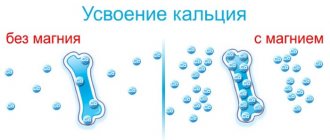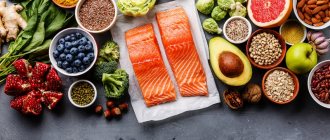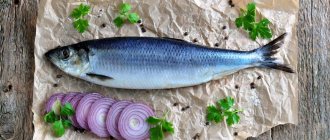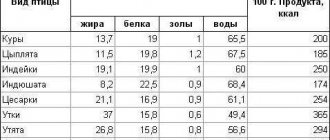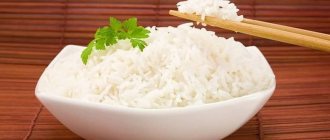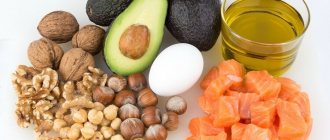General information
It is interesting that the mineral actively migrates in the biosphere; the accumulation of the compound in living organisms occurs due to inhalation of volcanic fumes, contact with calcareous rocks, thermal waters, and regular consumption of products grown in soil enriched with the microelement.
Selenium is actively dissolved in concentrated nitric acid and alkalis. In air, it is resistant to oxygen, water, sulfuric and hydrochloric acids.
In the human body, the mineral accumulates in the liver, kidneys, spleen, heart, bone marrow, lungs, skin and spermatic cords. The total concentration of the microelement in the internal organs does not exceed fourteen milligrams (match head). In microdoses it is found in the nuclei of all cells.
For better absorption of selenium, it is recommended to simultaneously take vitamins E,. At the same time, sulfates, mercury, phenacetin, copper, paracetamol, antimalarial drugs, on the contrary, reduce the absorption of the compound, which can ultimately lead to the development of mineral deficiency in the body.
Selenomethionine, selencysteine (the natural form of the compound) has the highest degree of digestibility - up to 98%. The body absorbs only 30% of the element from the animal form, and 10% from the inorganic form (sodium selenite).
Selenium functions
This microelement plays an important role in maintaining health. Thus, after the introduction of selenium into the diet of people, the number of cancer diseases decreased by 1.8 times, the number of heart pathologies - by 2.5, and diseases of the endocrine system decreased by 77%.
The role of the mineral in the human body.
- Part of 200 enzymes and hormones. In addition, an element in the form of the amino acid selenocysteine is present in proteins as a link.
- Increases stem cell activity, maintains skin elasticity, slowing down aging.
- Required for the formation of 80% of energy (ATP).
- Stimulates the body's antioxidant defense.
- Normalizes the activity of the hormones thyroxine (T4) and triiodothyronine (T3).
- Prevents the development of malignant neoplasms, cataracts, colitis, thrush, arthritis, psoriasis, bronchial asthma.
- Increases physical activity, improves sleep, mood, condition of nails, hair, skin, reduces the intensity of headaches.
- Participates in the synthesis of coenzyme Q-10.
- It is the main component of the glutathione enzyme, which protects internal organs from toxic substances formed during the breakdown of toxins.
- Improves fat, protein, carbohydrate metabolism.
- Suppresses histamine, exhibiting strong antidystrophic and antiallergic properties.
- Promotes tissue proliferation, strengthens the immune system, improves the functioning of the heart and gonads (activates the production of testosterone, reduces the risk of prostate cancer, increases the viability of sperm, the likelihood of conception in men and “delays” the onset of menopause in women).
- Protects the body from poisoning by exhaust gases, tobacco smoke, cadmium, lead, thallium, and neutralizes the harmful effects of mercury and arsenic.
- Stabilizes the activity of the endocrine and nervous systems.
Interestingly, selenium compounds restore low blood pressure during collapse or shock. Shampoos containing this mineral relieve dandruff from hair.
Selenium plays an important role in the body of a pregnant woman: it promotes the normal development of the fetus, reduces the likelihood of miscarriage and the appearance of pathologies, and also normalizes the unstable emotional state of the expectant mother.
With age, the amount of microelement in the body decreases: after 60 years by 7%, 75 by 24%.
Why is it needed?
Along with vitamins C and , selenium is a powerful antioxidant. It protects the body's cells from the action of free radicals - aggressive fragments of molecules. Selenium is part of special proteins - selenoproteins
, which are part of enzymes that fight free radicals.
Selenium is necessary for the proper functioning of the thyroid gland.
It helps the enzyme responsible for converting the main hormone of the gland, thyroxine,
into a biologically active form that directly affects metabolism.
Thyroxine increases a person’s physical and mental activity, promotes the growth and development of all body tissues, and even activates metabolism and prevents fat deposition. Another important function of selenium is maintaining the human reproductive system in working order. Selenium, together with zinc, allows male reproductive cells - sperm
- to maintain optimal mobility. Selenium, like folic acid, reduces the likelihood of miscarriage. And these substances protect the embryo from a defect in the development of the neural tube, which leads to the birth of babies with an underdeveloped spine. Selenium has a stimulating effect on the immune system. Research results indicate that it increases the body's resistance to many diseases.
Daily requirement
Let's consider in what doses selenium should be taken:
- infants 1 – 3 years old – 20 micrograms;
- children 4 – 8 years old – 30 micrograms;
- schoolchildren 9 – 13 years old – 40 micrograms;
- adolescents 14 – 18 years old – 55 micrograms;
- women 19 years of age and older – 55 micrograms;
- men 19 years of age and older – 70 micrograms;
- pregnant and breastfeeding women – 65 – 75 micrograms.
Indications for additional selenium intake: diseases of the pancreas, liver, biliary tract, cardiovascular system, infertility, hyperlipidemia.
The doctor selects the therapeutic dose based on the clinical picture of the disease.
Selenium deficiency
A deficiency of the compound in the body develops if a person regularly consumes less than 5 micrograms of the mineral per day. Newborns receive selenium through mother's milk.
Reasons for lack of connection:
- unfavorable environmental conditions;
- taking anabolic steroids;
- unbalanced diet;
- hard physical labor;
- the presence of arsenic compounds in food, water, air;
- intense sports activities;
- high nitrate content in greens and vegetables;
- consumption of meat from animals that are fed on growth hormones;
- taking anti-malaria drugs, laxatives, paracetamol;
- living in a region far from the sea or with a hot climate, as a result of which the element is actively excreted through sweat;
- abuse of semi-finished products, sweets, canned food.
Primary symptoms of selenium deficiency in the body (shortage up to 40%):
- decreased visual acuity;
- chronic fatigue, neuroses;
- low physical and mental endurance;
- premature aging, early menopause;
- frequent colds due to weakened immunity;
- skin pustular diseases;
- long-term tissue regeneration after damage to the skin (burns, cuts, injuries);
- lack of sexual desire, impotence, male infertility.
Consequences of chronic mineral deficiency (up to 100%):
- obesity or dystrophy;
- endemic goiter, thyroid dysfunction;
- oncological, gynecological diseases;
- hormonal disorders;
- atherosclerosis, hypertension, coronary heart disease;
- miscarriages, premature births;
- asthma, rheumatoid arthritis, endemic cretinism;
- Keshan, Kashin-Beck disease, the latter, in turn, leads to osteoarthropathy.
Overweight people most often suffer from a lack of selenium in the body. The reason for this relationship is that a deficiency of this mineral impairs the functioning of the thyroid gland, as a result, metabolism slows down and body weight is retained.
Selenium content in products
Table of percentage of selenium in food. The chart shows the percentage of selenium from the daily requirement, calculated based on a 100 g serving of the product.
| № | Quantity | Share of daily value per 100 g | |
| 1 | Brazilian nut | 1,917.0 mcg | 3 485,5% |
| 2 | Stewed pork kidneys | 311.5 mcg | 566,4% |
| 3 | Mustard seeds ground mustard | 208.1 mcg | 378,4% |
| 4 | Raw pork kidneys | 190.0 mcg | 345,5% |
| 5 | Boiled beef kidneys | 168.0 mcg | 305,5% |
| 6 | Beef kidneys raw | 141.0 mcg | 256,4% |
| 7 | Chicken egg yolk in powder form | 139.3 mcg | 253,3% |
| 8 | Powdered egg replacers | 127.7 mcg | 232,2% |
| 9 | Chicken egg white powder | 125.1 mcg | 227,5% |
| 10 | Puffed wheat ready to eat | 123.1 mcg | 223,8% |
| 11 | Stewed turkey liver | 102.3 mcg | 186,0% |
| 12 | Boiled mussels | 89.6 mcg | 162,9% |
| 13 | Boiled octopus | 89.6 mcg | 162,9% |
| 14 | Cooked cuttlefish | 89.6 mcg | 162,9% |
| 15 | Fried chicken liver | 88.2 mcg | 160,4% |
| 16 | Chicken liver stewed or boiled | 82.4 mcg | 149,8% |
| 17 | Roasted sunflower seeds (hulled) | 79.3 mcg | 144,2% |
| 18 | Dry egg noodles | 78.8 mcg | 143,3% |
| 19 | Unheated wheat bran | 77.6 mcg | 141,1% |
| 20 | Dry whole wheat noodles | 77.6 mcg | 141,1% |
| 21 | Salted mackerel | 73.4 mcg | 133,5% |
| 22 | Lobsters (lobsters, spiny lobsters) boiled | 73.1 mcg | 132,9% |
| 23 | Pork pancreas, cooked | 72.8 mcg | 132,4% |
| 24 | Dry wheat groats | 70.7 mcg | 128,5% |
| 25 | Tuna canned in its own juice | 70.6 mcg | 128,4% |
| 26 | Turkey liver raw | 68.7 mcg | 124,9% |
| 27 | Baked swordfish | 68.5 mcg | 124,5% |
| 28 | Raw goose liver | 68.1 mcg | 123,8% |
| 29 | Canned anchovies (in oil) | 68.1 mcg | 123,8% |
| 30 | Pork liver fried or stewed | 67.5 mcg | 122,7% |
| 31 | Duck liver raw | 67.0 mcg | 121,8% |
| 32 | Boiled shellfish | 64.0 mcg | 116,4% |
| 33 | Lobsters (lobsters, spiny lobsters) raw | 63.6 mcg | 115,6% |
| 34 | Dry noodles (pasta, pasta) | 63.2 mcg | 114,9% |
| 35 | Whole grain flour (wheat) | 61.8 mcg | 112,4% |
| 36 | Salted herring | 58.5 mcg | 106,4% |
| 37 | Sunflower flour | 58.2 mcg | 105,8% |
| 38 | Raw swordfish | 57.4 mcg | 104,4% |
| 39 | Cooked turkey heart | 56.8 mcg | 103,3% |
| 40 | Raw egg yolk | 56.0 mcg | 101,8% |
| 41 | Ginger extract powder | 55.8 mcg | 101,5% |
| 42 | Baked halibut | 55.4 mcg | 100,7% |
| 43 | Chia seeds | 55.2 mcg | 100,4% |
| 44 | Chicken liver raw | 54.6 mcg | 99,3% |
| 45 | Baked tilapia | 54.4 mcg | 98,9% |
| 46 | Sunflower seeds, peeled | 53.0 mcg | 96,4% |
| 47 | Raw pork liver | 52.7 mcg | 95,8% |
| 48 | Canned sardine in oil | 52.7 mcg | 95,8% |
| 49 | Smoked herring | 52.6 mcg | 95,6% |
| 50 | Abalone cooked | 51.8 mcg | 94,2% |
| 51 | Cooked squid (fried) | 51.8 mcg | 94,2% |
| 52 | Caviar, red or black, cooked (heat-treated) | 51.7 mcg | 94,0% |
| 53 | Baked mackerel | 51.6 mcg | 93,8% |
| 54 | Light beef boiled or stewed | 50.3 mcg | 91,5% |
| 55 | Pork spleen cooked | 49.6 mcg | 90,2% |
| 56 | Baked snapper (berix) | 49.0 mcg | 89,1% |
| 57 | Baked pollock | 46.8 mcg | 85,1% |
| 58 | Molva baked | 46.8 mcg | 85,1% |
| 59 | Cooked monkfish | 46.8 mcg | 85,1% |
| 60 | Baked grouper | 46.8 mcg | 85,1% |
| 61 | Baked chinook salmon | 46.8 mcg | 85,1% |
| 62 | Baked Yellowtail (Lacedra) | 46.8 mcg | 85,1% |
| 63 | Baked catfish | 46.8 mcg | 85,1% |
| 64 | Smoked butterfish (escolar) | 46.8 mcg | 85,1% |
| 65 | Baked chum salmon | 46.8 mcg | 85,1% |
| 66 | Baked mullet | 46.8 mcg | 85,1% |
| 67 | Mahi-mahi (korifena) baked | 46.8 mcg | 85,1% |
| 68 | Fried smelt | 46.8 mcg | 85,1% |
| 69 | Baked herring | 46.8 mcg | 85,1% |
| 70 | Baked salmon | 46.8 mcg | 85,1% |
| 71 | Baked seabass | 46.8 mcg | 85,1% |
| 72 | Baked Terpug | 46.8 mcg | 85,1% |
| 73 | Baked menek | 46.8 mcg | 85,1% |
| 74 | Dried shiitake mushrooms | 46.1 mcg | 83,8% |
| 75 | Halibut raw | 45.6 mcg | 82,9% |
| 76 | Cooked pork fillet | 45.4 mcg | 82,5% |
| 77 | Baked pork loin | 45.3 mcg | 82,4% |
| 78 | Unheated oat bran | 45.2 mcg | 82,2% |
| 79 | Raw mussels | 44.8 mcg | 81,5% |
| 80 | Abalone raw | 44.8 mcg | 81,5% |
| 81 | Octopus raw | 44.8 mcg | 81,5% |
| 82 | Raw squid | 44.8 mcg | 81,5% |
| 83 | Raw cuttlefish | 44.8 mcg | 81,5% |
| 84 | Beef lung raw | 44.3 mcg | 80,5% |
| 85 | Stewed turkey gizzards | 44.1 mcg | 80,2% |
| 86 | Raw mackerel | 44.1 mcg | 80,2% |
| 87 | Foie gras canned | 44.0 mcg | 80,0% |
| 88 | Pork baked in the oven | 43.6 mcg | 79,3% |
| 89 | Beaver meat cooked | 43.1 mcg | 78,4% |
| 90 | Boiled crab | 42.9 mcg | 78,0% |
| 91 | Fresh sprouted wheat | 42.5 mcg | 77,3% |
| 92 | Dried jellyfish | 42.2 mcg | 76,7% |
| 93 | Tilapia raw | 41.8 mcg | 76,0% |
| 94 | Liver pate | 41.6 mcg | 75,6% |
| 95 | Raw pork carbonate | 41.3 mcg | 75,1% |
| 96 | Chicken gizzards, boiled or stewed | 41.1 mcg | 74,7% |
| 97 | Baked whiting | 41.1 mcg | 74,7% |
| 98 | Raw pork pancreas | 40.8 mcg | 74,2% |
| 99 | Fried cooked pork | 40.5 mcg | 73,6% |
| 100 | Cooked stewed pork | 40.3 mcg | 73,3% |
| 101 | Caviar, red or black, raw | 40.3 mcg | 73,3% |
| 102 | Boiled pork stomach | 40.3 mcg | 73,3% |
| 103 | Boiled Kamchatka crab | 40.0 mcg | 72,7% |
| 104 | Beef liver raw | 39.7 mcg | 72,2% |
| 105 | Gluten (wheat gluten) in dry form | 39.7 mcg | 72,2% |
| 106 | Boiled beef heart | 38.9 mcg | 70,7% |
| 107 | Fried croaker | 38.8 mcg | 70,5% |
| 108 | Cooked rabbit meat | 38.5 mcg | 70,0% |
| 109 | Snapper (berix) raw | 38.2 mcg | 69,5% |
| 110 | Baked coho salmon | 38.0 mcg | 69,1% |
| 111 | Barley flour | 37.7 mcg | 68,5% |
| 112 | Malted barley flour | 37.7 mcg | 68,5% |
| 113 | Canned horse mackerel | 37.7 mcg | 68,5% |
| 114 | Dry pearl barley | 37.7 mcg | 68,5% |
| 115 | Dry barley groats | 37.7 mcg | 68,5% |
| 116 | Baked pink salmon | 37.6 mcg | 68,4% |
| 117 | Crab (crab meat) raw | 37.4 mcg | 68,0% |
| 118 | Raw goose egg | 36.9 mcg | 67,1% |
| 119 | Boiled crayfish | 36.7 mcg | 66,7% |
| 120 | Rye bread | 36.6 mcg | 66,5% |
| 121 | Menek raw | 36.5 mcg | 66,4% |
| 122 | Raw pollock | 36.5 mcg | 66,4% |
| 123 | Molva raw | 36.5 mcg | 66,4% |
| 124 | Monkfish raw | 36.5 mcg | 66,4% |
| 125 | Shark meat raw | 36.5 mcg | 66,4% |
| 126 | Anchovies raw | 36.5 mcg | 66,4% |
| 127 | Croaker raw | 36.5 mcg | 66,4% |
| 128 | Grouper raw | 36.5 mcg | 66,4% |
| 129 | Yellowtail (lacedra) raw | 36.5 mcg | 66,4% |
| 130 | Raw catfish | 36.5 mcg | 66,4% |
| 131 | Herring raw | 36.5 mcg | 66,4% |
| 132 | Raw salmon | 36.5 mcg | 66,4% |
| 133 | Seabass raw | 36.5 mcg | 66,4% |
| 134 | Chum salmon raw | 36.5 mcg | 66,4% |
| 135 | Raw mullet | 36.5 mcg | 66,4% |
| 136 | Coho salmon raw | 36.5 mcg | 66,4% |
| 137 | Raw mackerel | 36.5 mcg | 66,4% |
| 138 | Mahi-mahi (korifena) raw | 36.5 mcg | 66,4% |
| 139 | Raw smelt | 36.5 mcg | 66,4% |
| 140 | Chinook salmon raw | 36.5 mcg | 66,4% |
| 141 | Oilfish (escolar) raw | 36.5 mcg | 66,4% |
| 142 | Kamchatka crab raw | 36.4 mcg | 66,2% |
| 143 | Raw ostrich meat, tenderloin | 36.4 mcg | 66,2% |
| 144 | Raw duck egg | 36.4 mcg | 66,2% |
| 145 | Boiled whole wheat noodles | 36.3 mcg | 66,0% |
| 146 | Bread crackers | 36.2 mcg | 65,8% |
| 147 | Boiled or stewed turkey neck | 36.2 mcg | 65,8% |
| 148 | Beef liver, stewed or fried | 36.1 mcg | 65,6% |
| 149 | Baked sockeye salmon | 35.5 mcg | 64,5% |
| 150 | Turkey heart raw | 35.4 mcg | 64,4% |
| 151 | Cooked minced pork (20% fat) | 35.4 mcg | 64,4% |
| 152 | Sea bass (red) baked | 34.6 mcg | 62,9% |
| 153 | Unroasted sesame | 34.4 mcg | 62,5% |
| 154 | Roasted sesame | 34.4 mcg | 62,5% |
| 155 | Turkey egg raw | 34.3 mcg | 62,4% |
| 156 | Oat flour | 34.0 mcg | 61,8% |
| 157 | Fried shark meat | 34.0 mcg | 61,8% |
| 158 | All-purpose wheat flour | 33.9 mcg | 61,6% |
| 159 | Milk Protein Supplement Powder | 33.8 mcg | 61,5% |
| 160 | Salami | 33.6 mcg | 61,1% |
| 161 | Table mustard, paste | 33.5 mcg | 60,9% |
| 162 | Raw pork loin | 33.2 mcg | 60,4% |
| 163 | Raw pork, meat with fat | 33.1 mcg | 60,2% |
| 164 | Fried chicken egg | 33.1 mcg | 60,2% |
| 165 | Multigrain bread | 32.9 mcg | 59,8% |
| 166 | Raw pork spleen | 32.8 mcg | 59,6% |
| 167 | Millet flour | 32.7 mcg | 59,5% |
| 168 | Fried flounder | 32.6 mcg | 59,3% |
| 169 | Pork meat without fat (fillet) raw | 32.4 mcg | 58,9% |
| 170 | Pork ribs (country) raw | 32.3 mcg | 58,7% |
| 171 | Merlang raw | 32.1 mcg | 58,4% |
| 172 | Raw quail egg | 32.0 mcg | 58,2% |
| 173 | Chicken breast, boiled or stewed (without skin) | 31.9 mcg | 58,0% |
| 174 | Cooked lamb | 31.7 mcg | 57,6% |
| 175 | Raw crayfish | 31.6 mcg | 57,5% |
| 176 | Baked turkey thigh (fillet) | 31.4 mcg | 57,1% |
| 177 | Pink salmon raw | 31.4 mcg | 57,1% |
| 178 | Cooked beef (meat without fat) | 31.3 mcg | 56,9% |
| 179 | Raw pork stomach | 31.1 mcg | 56,5% |
| 180 | Bison meat cooked | 31.1 mcg | 56,5% |
| 181 | Wheat bran bread | 31.0 mcg | 56,4% |
| 182 | Rye bread | 30.9 mcg | 56,2% |
| 183 | Boiled chicken egg (hard-boiled) | 30.8 mcg | 56,0% |
| 184 | Turkey meat (turkey meat) baked (whole carcass meat) | 30.7 mcg | 55,8% |
| 185 | Raw chicken egg | 30.7 mcg | 55,8% |
| 186 | Baked oysters | 30.7 mcg | 55,8% |
| 187 | Raw shellfish | 30.6 mcg | 55,6% |
| 188 | Pork tenderloin raw | 30.3 mcg | 55,1% |
| 189 | Boiled turkey breast (fillet) | 30.2 mcg | 54,9% |
| 190 | Baked turkey drumstick (without skin) | 30.2 mcg | 54,9% |
| 191 | Oat bran bread | 30.0 mcg | 54,5% |
| 192 | Sprouted wheat bread | 30.0 mcg | 54,5% |
| 193 | Swiss cheese | 30.0 mcg | 54,5% |
| 194 | Raw sockeye salmon | 29.8 mcg | 54,2% |
| 195 | Roasted turkey (meat and skin of the whole carcass) | 29.8 mcg | 54,2% |
| 196 | Dried openwork chervil | 29.3 mcg | 53,3% |
| 197 | Dried coriander (cilantro) leaf | 29.3 mcg | 53,3% |
| 198 | Pepperoni sausage | 29.0 mcg | 52,7% |
| 199 | Dry oat flakes (instant) | 28.9 mcg | 52,5% |
| 200 | White wheat bread | 28.8 mcg | 52,4% |
| 201 | Turkey gizzards raw | 28.8 mcg | 52,4% |
| 202 | Rice bran bread | 28.7 mcg | 52,2% |
| 203 | Sea bass (red) raw | 28.6 mcg | 52,0% |
| 204 | Turkey neck raw | 28.6 mcg | 52,0% |
| 205 | Cheddar cheese | 28.5 mcg | 51,8% |
| 206 | Baked chicken breast (skinless) | 28.4 mcg | 51,6% |
| 207 | Wheat flour | 28.1 mcg | 51,1% |
| 208 | Surimi raw | 28.1 mcg | 51,1% |
| 209 | Dry variegated beans (Pinto) | 27.9 mcg | 50,7% |
| 210 | Naan flatbread Indian wheat flatbread | 27.9 mcg | 50,7% |
| 211 | Mozzarella cheese | 27.6 mcg | 50,2% |
| 212 | First grade wheat flour | 27.5 mcg | 50,0% |
| 213 | Couscous boiled in water | 27.5 mcg | 50,0% |
| 214 | Raw snails | 27.4 mcg | 49,8% |
| 215 | Pita | 27.1 mcg | 49,3% |
| 216 | Pork intestines cooked | 27.0 mcg | 49,1% |
| 217 | Baked chicken drumstick (meat with skin) | 26.9 mcg | 48,9% |
| 218 | Whey protein powder | 26.7 mcg | 48,5% |
| 219 | Beaver meat raw | 26.6 mcg | 48,4% |
| 220 | Raw flounder | 26.6 mcg | 48,4% |
| 221 | Hot Dog | 26.5 mcg | 48,2% |
| 222 | Boiled noodles (pasta, pasta) | 26.4 mcg | 48,0% |
| 223 | Hamburger (McDonald's) | 26.2 mcg | 47,6% |
| 224 | Second grade wheat flour | 26.2 mcg | 47,6% |
| 225 | Sweet yeast dough buns | 26.2 mcg | 47,6% |
| 226 | Coriander seeds | 26.2 mcg | 47,6% |
| 227 | Pork neck (neck) raw | 26.2 mcg | 47,6% |
| 228 | Brown raw champignons | 26.0 mcg | 47,3% |
| 229 | Beef brain fried | 26.0 mcg | 47,3% |
| 230 | Egg omelette | 25.8 mcg | 46,9% |
| 231 | Raw pork belly | 25.8 mcg | 46,9% |
| 232 | Whole grain wheat bread | 25.7 mcg | 46,7% |
| 233 | Baked chicken legs (meat with skin) | 25.7 mcg | 46,7% |
| 234 | Raw chicken gizzards | 25.5 mcg | 46,4% |
| 235 | Baked chicken wings | 25.5 mcg | 46,4% |
| 236 | Dry baked muesli (granola), crispy, with honey | 25.4 mcg | 46,2% |
| 237 | Raw beef, meat without fat | 25.4 mcg | 46,2% |
| 238 | Flaxseed | 25.4 mcg | 46,2% |
| 239 | Baked chicken thighs (meat with skin) | 25.3 mcg | 46,0% |
| 240 | Breadcrumbs | 25.2 mcg | 45,8% |
| 241 | Dry steamed brown rice | 25.2 mcg | 45,8% |
| 242 | Shiitake mushrooms, cooked | 24.8 mcg | 45,1% |
| 243 | Oat bread | 24.6 mcg | 44,7% |
| 244 | Raw minced pork, 20% fat | 24.6 mcg | 44,7% |
| 245 | Fried chicken | 24.5 mcg | 44,5% |
| 246 | Boiled egg noodles | 23.9 mcg | 43,5% |
| 247 | Dried garlic | 23.9 mcg | 43,5% |
| 248 | Raw rabbit meat | 23.7 mcg | 43,1% |
| 249 | Semolina dry semolina | 23.5 mcg | 42,7% |
| 250 | Raw lamb | 23.4 mcg | 42,5% |
| 251 | Boiled pork lung | 23.4 mcg | 42,5% |
| 252 | Raw pork feet | 23.3 mcg | 42,4% |
| 253 | Boiled pork legs | 23.0 mcg | 41,8% |
| 254 | Crab sticks (surimi) ready to eat | 22.9 mcg | 41,6% |
| 255 | Chicken breast fillet, raw meat, without skin | 22.8 mcg | 41,5% |
| 256 | Turkey drumstick, raw, without skin | 22.7 mcg | 41,3% |
| 257 | Turkey breast (fillet) raw | 22.7 mcg | 41,3% |
| 258 | Turkey meat (turkey meat), raw, whole carcass meat | 22.6 mcg | 41,1% |
| 259 | Doctor's sausage | 22.6 mcg | 41,1% |
| 260 | Parmesan cheese | 22.5 mcg | 40,9% |
| 261 | Turkey thigh (fillet) raw | 22.4 mcg | 40,7% |
| 262 | Duck (duck meat) baked (meat without skin) | 22.4 mcg | 40,7% |
| 263 | Raw pork ribs (ribs) | 22.0 mcg | 40,0% |
| 264 | Baked chicken | 22.0 mcg | 40,0% |
| 265 | Fried portobello mushrooms | 21.9 mcg | 39,8% |
| 266 | Baked goose | 21.8 mcg | 39,6% |
| 267 | Beef heart raw | 21.8 mcg | 39,6% |
| 268 | Cooked scallop | 21.7 mcg | 39,5% |
| 269 | Raw pork shoulder | 21.5 mcg | 39,1% |
| 270 | Beef brain raw | 21.3 mcg | 38,7% |
| 271 | Raw turkey, meat and skin of the whole carcass | 21.3 mcg | 38,7% |
| 272 | Fried chicken wings | 21.3 mcg | 38,7% |
| 273 | Dry muesli (with dried fruits and nuts) | 21.2 mcg | 38,5% |
| 274 | Boiled or stewed chicken | 20.9 mcg | 38,0% |
| 275 | Fried chicken legs (meat with skin) | 20.8 mcg | 37,8% |
| 276 | Ham | 20.7 mcg | 37,6% |
| 277 | Cooked pheasant | 20.7 mcg | 37,6% |
| 278 | Ground dry chili pepper | 20.4 mcg | 37,1% |
| 279 | Raw chicken drumstick, meat with skin | 20.2 mcg | 36,7% |
| 280 | Bison meat raw | 20.0 mcg | 36,4% |
| 281 | Raw egg white | 20.0 mcg | 36,4% |
| 282 | Dry steamed rice | 19.9 mcg | 36,2% |
| 283 | Cashew raw | 19.9 mcg | 36,2% |
| 284 | Cooked chicken back (meat with skin) | 19.9 mcg | 36,2% |
| 285 | Fried chicken thighs (meat with skin) | 19.9 mcg | 36,2% |
| 286 | Raw pork ham and rump | 19.7 mcg | 35,8% |
| 287 | Raw oysters | 19.7 mcg | 35,8% |
| 288 | Chicken drumstick (without skin) fried | 19.6 mcg | 35,6% |
| 289 | Pork knuckle, raw shank | 19.5 mcg | 35,5% |
| 290 | Cheese Queso Fresco | 19.3 mcg | 35,1% |
| 291 | Raw chicken thighs, meat with skin | 18.9 mcg | 34,4% |
| 292 | Boiled or stewed chicken legs (meat with skin) | 18.9 mcg | 34,4% |
| 293 | Dry amaranth groats (seeds) | 18.7 mcg | 34,0% |
| 294 | Raw portobello mushrooms | 18.6 mcg | 33,8% |
| 295 | Unsweetened coconut flakes | 18.5 mcg | 33,6% |
| 296 | Pork brain cooked | 18.5 mcg | 33,6% |
| 297 | Chicken wings, boiled or stewed | 18.5 mcg | 33,6% |
| 298 | Fried chicken drumstick (meat with skin) | 18.4 mcg | 33,5% |
| 299 | Boiled or stewed pork heart | 18.3 mcg | 33,3% |
| 300 | Baked omul | 18.1 mcg | 32,9% |
| 301 | Chicken drumstick (without skin), stewed or boiled | 18.0 mcg | 32,7% |
| 302 | Chicken legs (legs) raw, meat with skin | 18.0 mcg | 32,7% |
| 303 | Chicken thighs, boiled or stewed (meat with skin) | 17.9 mcg | 32,5% |
| 304 | Molasses | 17.8 mcg | 32,4% |
| 305 | Raw pork lung | 17.8 mcg | 32,4% |
| 306 | Soybeans, mature, dry | 17.8 mcg | 32,4% |
| 307 | Mexican Cotija cheese | 17.7 mcg | 32,2% |
| 308 | Rye flour | 17.6 mcg | 32,0% |
| 309 | Smoked sausage | 17.6 mcg | 32,0% |
| 310 | Raw chicken wings | 17.6 mcg | 32,0% |
| 311 | Multigrain crispbread | 17.4 mcg | 31,6% |
| 312 | Fermented tofu cheese (fuyu) | 17.3 mcg | 31,5% |
| 313 | Butternut | 17.2 mcg | 31,3% |
| 314 | Dry long grain brown rice | 17.1 mcg | 31,1% |
| 315 | Skinless chicken thighs, boiled or stewed | 17.1 mcg | 31,1% |
| 316 | Black Walnut | 17.0 mcg | 30,9% |
| 317 | Sponge cake layers for cake | 17.0 mcg | 30,9% |
| 318 | Dry corn grits | 17.0 mcg | 30,9% |
| 319 | Chicken drumstick, stewed or boiled (meat with skin) | 17.0 mcg | 30,9% |
| 320 | Ricotta cheese | 16.7 mcg | 30,4% |
| 321 | Chicken breast raw, skin on | 16.6 mcg | 30,2% |
| 322 | Unheated corn bran | 16.5 mcg | 30,0% |
| 323 | Powdered milk | 16.3 mcg | 29,6% |
| 324 | Baked burbot | 16.2 mcg | 29,5% |
| 325 | Baked trout | 16.2 mcg | 29,5% |
| 326 | Baked milkfish (hanos) | 16.2 mcg | 29,5% |
| 327 | Baked river perch | 16.2 mcg | 29,5% |
| 328 | Baked sturgeon | 16.2 mcg | 29,5% |
| 329 | Cooked pike | 16.2 mcg | 29,5% |
| 330 | Baked carp | 16.2 mcg | 29,5% |
| 331 | Baked pike perch | 16.2 mcg | 29,5% |
| 332 | Pig brain, raw | 15.9 mcg | 28,9% |
| 333 | Focaccia | 15.9 mcg | 28,9% |
| 334 | Chicken raw chicken meat | 15.7 mcg | 28,5% |
| 335 | Raw pheasant meat | 15.7 mcg | 28,5% |
| 336 | Unheated rice bran | 15.6 mcg | 28,4% |
| 337 | Blood sausage | 15.5 mcg | 28,2% |
| 338 | Boiled pork tongue | 15.5 mcg | 28,2% |
| 339 | Dry corn kernels | 15.5 mcg | 28,2% |
| 340 | White whole grain corn flour | 15.4 mcg | 28,0% |
| 341 | Yellow whole grain corn flour | 15.4 mcg | 28,0% |
| 342 | Canned straw mushrooms | 15.2 mcg | 27,6% |
| 343 | Dry long grain rice | 15.1 mcg | 27,5% |
| 344 | Dry glutinous (sticky) rice | 15.1 mcg | 27,5% |
| 345 | Rice flour | 15.1 mcg | 27,5% |
| 346 | Raw pork intestines | 15.1 mcg | 27,5% |
| 347 | Dry rice noodles | 15.1 mcg | 27,5% |
| 348 | Ground beef, raw, 20% fat | 15.0 mcg | 27,3% |
| 349 | Chees Feta | 15.0 mcg | 27,3% |
| 350 | Condensed milk | 14.8 mcg | 26,9% |
Excess selenium
The toxic dose for the body that causes poisoning is 5 milligrams of the mineral per day.
The most dangerous to human health are selenic acid, selenic acid and hydrogen selenide.
Causes of microelement overdose.
- Selenium metabolism disorder.
- During professional activities. Excess of the compound in the body is observed in workers in the glass, oil refining, foundry, electronics, paint and varnish, copper smelting industries. In addition, people involved in the production of selenium sulfide, sodium selenite (pharmaceuticals), and pesticides (chemical industry) are at risk.
- Increased mineral content in the soil (USA, Australia, China).
- The supply of selenium with plants - concentrators (Happlopappus, astragalus, Stanlea).
It is almost impossible to obtain an overdose of a microelement from food, only in the case of uncontrolled consumption of Brazil nuts.
Symptoms of excess selenium in the body:
- convulsions;
- weakness;
- gastroenterocolitis;
- headache;
- severe cough, feeling of tightness in the chest;
- nausea and vomiting;
- garlicky skin odor;
- pain in the eyes;
- diarrhea;
- loss of appetite;
- hair loss, tooth sensitivity, brittle nails;
- peeling of the skin;
- constant fatigue;
- hysterical state.
Consequences of an overdose of the compound:
- blockade of sulfhydryl groups, which leads to enzyme inactivation;
- protein metabolism disorder;
- decreased blood pressure;
- disruptions in the functioning of the nervous system;
- increased permeability of capillary walls;
- development of atony, anemia, arthritis, bronchopneumonia, liver damage.
In severe cases, death is possible.
Best materials of the month
- Coronaviruses: SARS-CoV-2 (COVID-19)
- Antibiotics for the prevention and treatment of COVID-19: how effective are they?
- The most common "office" diseases
- Does vodka kill coronavirus?
- How to stay alive on our roads?
Remember, an excess of selenium can accelerate the growth of malignant tumors, so you should carefully monitor the amount of compound consumed per day.
Poisoning with this mineral is treated by administering sodium thiosulfate, glucose and a diet that involves strictly limiting the diet. The following are allowed: simple carbohydrates, rice, oatmeal, casein (milk protein).
How many do you need?
The daily requirement of an adult for selenium is approximately
50 mcg. Children under one year old need significantly less of this substance - about 20 mcg.
But, since selenium is toxic in large doses
, experts do not recommend consuming more than 400 mcg per day.
The upper limit for infants is 45 mcg per day. This mainly applies to those who receive selenium in the form of vitamin and mineral preparations or dietary supplements. Along with food, an overdose of selenium can only be obtained in those areas where the soil is oversaturated with it. Russia is one of the regions experiencing selenium deficiency.
